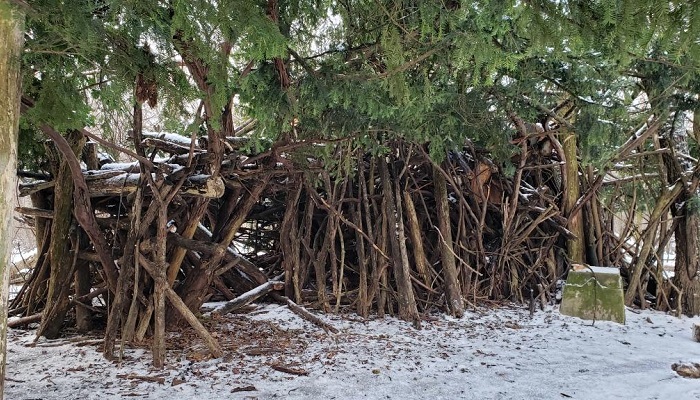With so many people enjoying time in the Forest Preserves during the pandemic, our staff has been finding more and more forts and other structures among the trees. Stacking up logs and sticks for a lean-to or a mini-log cabin seems like a fun activity with kids or friends. But you might be surprised to learn how troublesome these structures can be.
“Dead wood” is actually far from dead. Logs play a vital role in the lifecycles of hundreds of species of wildlife, providing a place to nest, rest, eat and grow. Snakes hide in logs in the winter and sun themselves on them in the summer, and insects and herps like local salamanders use rotting logs as shelter and a source of food. Many species of fungi grow only on dead wood, breaking it down and returning important nutrients to the soil. Disturbing logs on the ground can disturb these habitats.
When building a fort, people may also trample grasses and wildflowers around the structure. And if left up, a structure creates an ecological dead zone—light can’t penetrate the structure, causing plants on the forest floor to die.
Bigger or more sturdy forts can last a long time, and they tend to attract more than just the people or families who built them. Because of this traffic, we’ve seen new trails develop to and from structures, meaning more plants and flowers are trampled. With 5.2 million people in Cook County, if we didn’t actively remove these structures, our preserves would be overrun with forts, completely changing the view of nature during a walk in the woods.
We love sharing the excitement and wonder of exploring and interacting with nature out in the preserves. But please leave the logs on the ground, where they can remain part of the living local ecosystem.
There are plenty of ways the public can find an adventure in the Forest Preserves and use their curiosity and skills for the good of the forest and its inhabitants. Here are just some ideas:
- Observe life on a log. Look for moss, fungi, signs of animal homes and meals.
- Visit one of the Preserves’ designated nature play areas, available at most nature centers and campgrounds.
- Check out our schedule of events for one of the Preserves’ periodic events on building with natural materials.
- Participate in a volunteer stewardship day and help build a brush pile with all the buckthorn and other invasive plants we are trying to eliminate.

